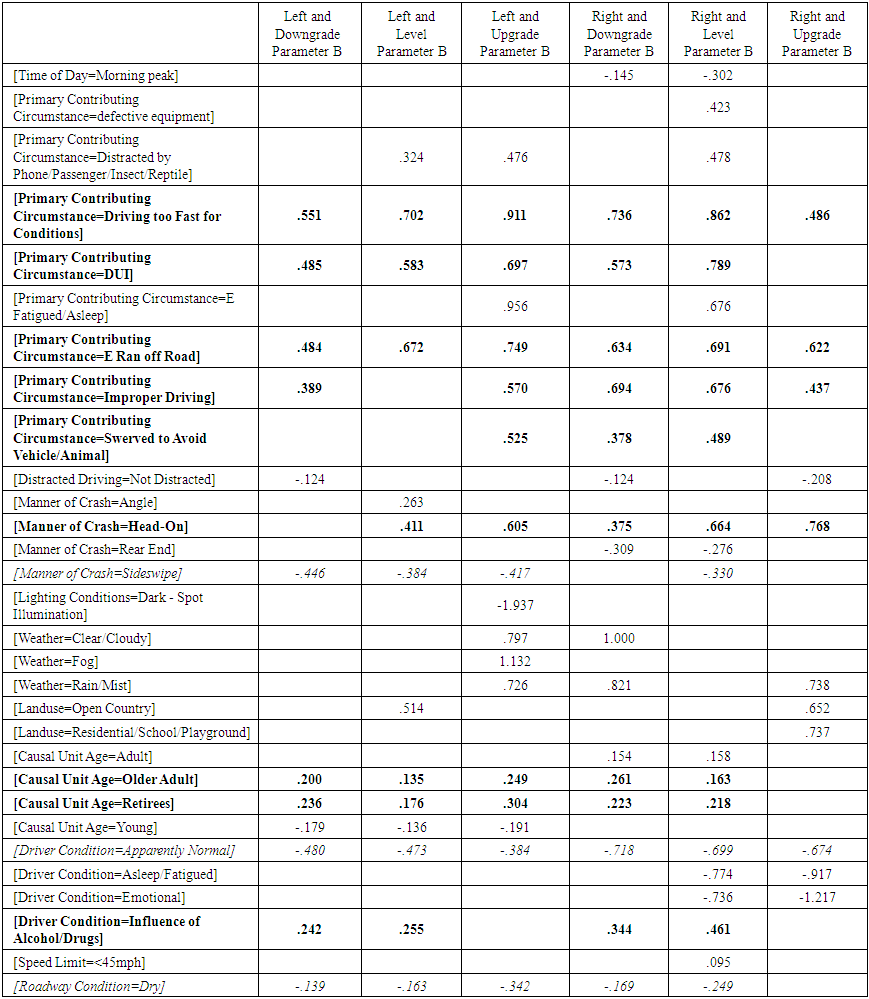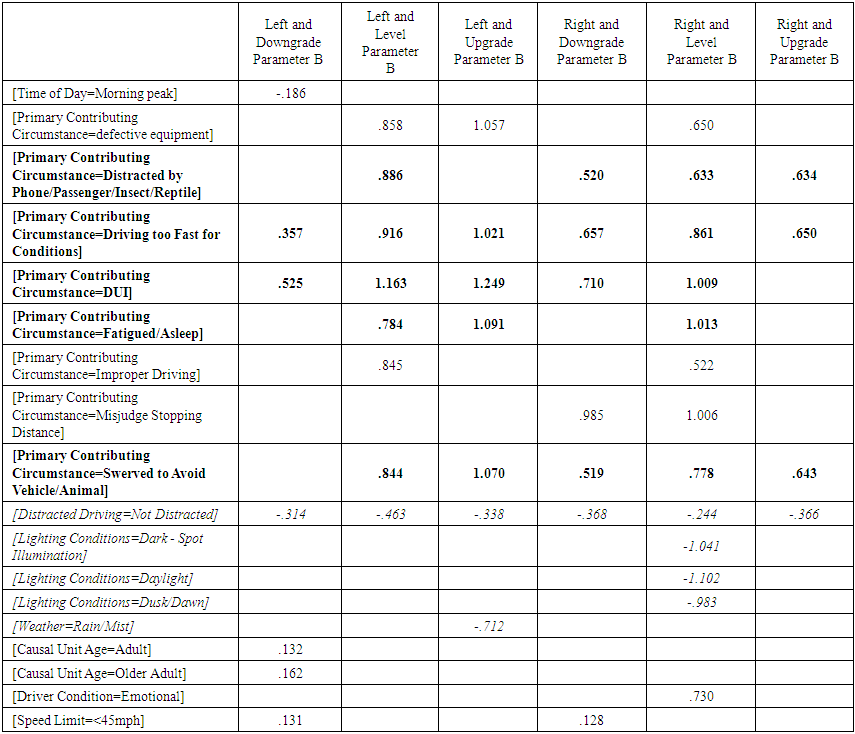-
Paper Information
- Next Paper
- Paper Submission
-
Journal Information
- About This Journal
- Editorial Board
- Current Issue
- Archive
- Author Guidelines
- Contact Us
International Journal of Statistics and Applications
p-ISSN: 2168-5193 e-ISSN: 2168-5215
2018; 8(2): 35-41
doi:10.5923/j.statistics.20180802.01

Binary Probit Crash Analysis for Various Curve and Grade Conditions
Mehrnaz Doustmohammadi 1, Michael Anderson 2
1Research Scientist, Civil Engineering, University of Alabama in Huntsville, Huntsville, 35899, United States
2Professor, Civil Engineering, University of Alabama in Huntsville, Huntsville, 35899, United States
Correspondence to: Mehrnaz Doustmohammadi , Research Scientist, Civil Engineering, University of Alabama in Huntsville, Huntsville, 35899, United States.
| Email: |  |
This work is licensed under the Creative Commons Attribution International License (CC BY).
http://creativecommons.org/licenses/by/4.0/

Traffic crashes occur at different rates depending on several geometric conditions and actions of the drivers. Hills and curves have different crash rates and severities that level and straight segments of roadway. This paper presents data that were collected and analyzed using a binary probit model to determine the characteristics associated with higher crash severity of different grades (level, upgrade and downgrade) along with curve conditions (straight, turning left and turning right). Additionally, the paper continues the use of the binary probit model to analyze specific aspects that lead to run off the road crashes. The models developed in this research show that crash severity and run off the road crashes are often due to driver operating characteristics and not environmental or roadway factors. The application of the binary probit model demonstrates a convenient tool to analyze a large number of variables containing categorical crash data.
Keywords: Binary Probit, Crash Modeling, Geometric Conditions
Cite this paper: Mehrnaz Doustmohammadi , Michael Anderson , Binary Probit Crash Analysis for Various Curve and Grade Conditions, International Journal of Statistics and Applications, Vol. 8 No. 2, 2018, pp. 35-41. doi: 10.5923/j.statistics.20180802.01.
Article Outline
1. Introduction and Background
- Traffic crashes have various causes ranging from environmental issues, driver ability levels, overall distractions, sight distance limitations, to basic roadway geometrics. Regarding roadway geometrics, crash data collected from Alabama between 2010 and 2014 show that straight horizontal alignment with a level grade is the safest driving environment with respect to severe crashes, essentially those crashes that result in an incapacitating injury or fatality, with less than 5 percent of the crashes that occur on these roadway segments resulting in a severe crash [1]. Contrarily, of the crashes that occur on roadway segments that curve to the left on a downgrade, almost 14 percent of crashes result in severe crashes [1]. For comparison purposes, 11 percent of the crashes on roadways curving right and downgrade were classified as severe [1]. Table 1 contains the percent of severe crashes of all crashes that occur on the particular horizontal alignment and grade.
|
2. Model Description
- A Binary Probit model is used in this paper. The use of probit modeling for crash analysis is common in the recent literature and several studies have provided examples and demonstrated use of the model for crash analysis [19-24]. The goal of the probit model is to model a series of observations of possible outcomes, severe and not severe, based on a collection of observed data values that are intended to relate the outcome [25, 26]. The definitions of the variables Y and X are as follows:• Let Y, for any subset i, be a binary response variable such that Yi = 1 if the trait is present in observation and Yi = 0 if the trait is not present in observation. • Let X = (X1, X2, ..., Xk) be a set of explanatory variables which can be discrete, continuous, or a combination. xi is the observed value of the explanatory variables for observation. For our analysis, the response variable will be Yi = 1 when a crash with a certain severity is observed and Yi = 0 if the alternate severity is recorded. The explanatory variables X1, X2, ..., Xk will be collected from the crash analysis database as an attempt to define the dependent variable.In the model, let i be the individual driver and K indicate the severity of crash, either K=0 for non-severe and K=1 for severe. The individual variables that relate to the outcome being severe or not severe are associated with environmental and driver and infrastructure factors present at the time, location and characteristics of those involved in the crash.The model specifically takes the form Pr(Y=1|X) = Φ(XTβ) where Pr is the probability and Φ is the Cumulative Distribution Function of the standard normal distribution. The parameters of the model, β, are estimated by maximum likelihood. The model is often depicted using a latent variable model where the likelihood of a severe injury or fatality occurring as a result from an individual crash, yi*, is associated with a collection of variables and parameters that are compared with a threshold value Ψ such that:• Yi = 0 if yi*<Ψ, the crash is not severe Or • Yi=1 if yi*>Ψ, the crash is severewhere Ψ=(XTβ).The maximum likelihood estimation is developed using the equation:
 | (1) |
3. Data Collection
- The data used in this analysis were extracted from the Critical Analysis Reporting Environment (CARE) maintained by the Center for Advance Public Safety at the University of Alabama (1a). Data were separated by horizontal curvature movement (left or right) and vertical alignment (level, upgrade or downgrade). There were six unique datasets developed for which the crash models were developed. The number of data variables that are available for each of the six categories is shown in Table 2.
|
|
4. Model Results
- The model generates parameter estimates for the variables to best match the actual number of severe and non-severe crashes at the different curve and grades. The parameters can be used to determine the direction of the variable as to the respect of the increase or decrease in the severity of crashes. The parameters indicated the probability executed increase with a one unit increase in the dependent variable [27, 28]. Table 4 presents the parameter estimates for the six categories; note that only the significant variables are displayed in the table.
 | Table 4. Parameters Estimates for the Models |
5. Run off the Road Model
- The paper continues to analyze the crashes associated with roadway grade and curvature specifically examining run off the road crashes. The importance of these crashes is evident from the statistic that 59 percent of all motor vehicle fatalities are run off the road crashes [29, 30]. The analysis of run off the road crashes has been studied recently by Gong who developed mixed logit models using driver age to test the crash severity [31, 32]. Additionally, the review of counter-measures for run off the road crashes has been modeled [33-38]. A binary probit model was developed for each roadway curvature and grade condition with the response variable being a run off the road crash or another type of crash and the independent variable previous defined, with the inclusion of a severity variable defined as severe and not severe. The significant parameters for each of the variables in each of the categories are shown in Table 5.
 | Table 5. Parameters Estimates for the Run Off the Road Models |
6. Conclusions
- This paper examined the crashes that occurred at multiple levels of curvature and grade conditions. The severity of crashes for all roadway grade and curve conditions was reduced by driving in dry condition and staying alert. The statistics also show that younger driver tend to have fewer severe crashes, while this might be attributed to younger drivers being less likely to admit to injuries more than younger drivers being more cautious while driving. Driving too fast, under the influence and distracted were key elements that tended to lead to increases in severity of crashes. Also, drivers who were older were shown to have increased severity on crashes occurring on all turning movement conditions, regardless of whether the roadway was level, traveling uphill or downhill. Specifically for run off the road crashes, the presence of an alert driver with lighting in specific situations can greatly reduce the number of these crashes. Other actions that can possibly reduce the number of run off the road crashes include education and enforcement with respect to aggressive, distracted and impaired driving.The contribution of the paper is the use of the binary probit modeling procedure to determine the statistical impact of categorical data on severity and for run off the road crashes. This methodology of crash analysis has not been observed in the literature; therefore this paper is a first attempt to demonstrate the ability of the model. The benefit of this modeling process is the ability to determine the contribution of a large number of categorical data. The parameter estimates are shown to provide a straight-forward means to determine which variables have an increase in the number of crashes or in the severity of crashes. While the parameters represent probability of increases, the sign of the parameters provides a quick methodology to determine the increase or decrease and the magnitude of the parameter provides an easy reference point to determine which factors have the greatest impact.
 Abstract
Abstract Reference
Reference Full-Text PDF
Full-Text PDF Full-text HTML
Full-text HTML

